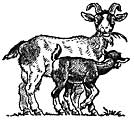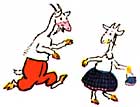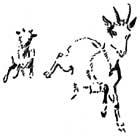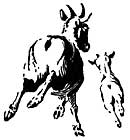|
|
 The Goat: An Unexpected Pet The Goat: An Unexpected Pet
by Marjorie Dorfman
Why are Nigerian Dwarf goats so very popular? What is their secret appeal among the young and the young at heart? Read on for a bit of knowledge but a lot more magic.
I never met a goat I didn’t like. – The Dorfman Archives
Being a city person for most of my life, I never actually made the acquaintance of a goat until I moved out to Bucks County, Pennsylvania. I owned my own horse, a white mare named Sadie Mae. I kept her on a farm which almost every domestic creature known to the modern world called home. There, in the back of the stable, I met Joshua, a most engaging caprine with an enormous appetite and adorable personality. I do not know which breed or how long or short his pedigree was. However, after knowing him, I became convinced that Joshua was and should always be in a class all by himself.
 I had always thought of goats as either distant creatures living on some mountaintop or as a group of unfortunate souls who were always being blamed for the actions of others. Until I met Joshua, I had never considered them as pets or playmates. I went to the stable every Thursday morning, always bringing a treat or two for my horse. One day I made the mistake of giving one of Sadie’s treats to Joshua who lived in a large pen in the yard behind the stable. After that, every time he saw me, he would carry on until I gave him a treat.
I had always thought of goats as either distant creatures living on some mountaintop or as a group of unfortunate souls who were always being blamed for the actions of others. Until I met Joshua, I had never considered them as pets or playmates. I went to the stable every Thursday morning, always bringing a treat or two for my horse. One day I made the mistake of giving one of Sadie’s treats to Joshua who lived in a large pen in the yard behind the stable. After that, every time he saw me, he would carry on until I gave him a treat.
One morning he was wandering about while I was walking my horse into the ring where my trainer awaited. I sensed a presence behind me and turned around, only to discover Joshua pilfering one of Sadie’s carrots from my back pocket. When I tried to pet him, he was already on his way back to his pen. I could have sworn he was laughing at me, but perhaps I was mistaken. In any case, I am not one to hold a grudge against any member of the animal kingdom. (I can’t speak for Sadie Mae though. She didn’t like the idea of losing her carrot at all!)
 My experience with goats was expanded a few years later when a close personal friend purchased Lucky and Oreo, two Nigerian Dwarf bucks. Their horns had been surgically removed because of their constant exposure to my friend’s small children. There are several recognized breeds of these dwarf goats of West African origin, and it is from these herds that the first dwarf goats were imported into the United States. The first documented imports arrived early in the last century and continued through the 1960s. These miniature goats are lovable and gentle pets and they provide a wholesome source of dairy products for family or homestead farm consumption. They present a broad range of body types and colors, with some carrying genes for greater stature. Nigerian Dwarves are still considered rare by the American livestock Breeds Conservancy, with their numbers totaling about 7,000 in the national registers. My experience with goats was expanded a few years later when a close personal friend purchased Lucky and Oreo, two Nigerian Dwarf bucks. Their horns had been surgically removed because of their constant exposure to my friend’s small children. There are several recognized breeds of these dwarf goats of West African origin, and it is from these herds that the first dwarf goats were imported into the United States. The first documented imports arrived early in the last century and continued through the 1960s. These miniature goats are lovable and gentle pets and they provide a wholesome source of dairy products for family or homestead farm consumption. They present a broad range of body types and colors, with some carrying genes for greater stature. Nigerian Dwarves are still considered rare by the American livestock Breeds Conservancy, with their numbers totaling about 7,000 in the national registers.
Color is one of the factors that makes breeding Dwarfs so popular. One can never be sure what color the babies will be until they are born and sometimes even then it isn’t certain because their colors change as they age. There are three main color lines: black, chocolate and gold, which can be broken with virtually every color combination imaginable. Dwarves can be Dalmatian spotted, pinto-patterned, tri-colored or just shades of solid black, white, chocolate or gold. Buckskin patterns are also popular, described as contrasting facial stripes, a "cape" around the shoulders with coordinating leg markings. Brown eyes are most common, but dwarves with china blue eyes are becoming increasingly available. Once you look into them, no matter what color they are, you are hooked for life.
Bucks are usually no more than 23 inches at the withers and does are no more than 21 inches. They are perfect pets for families with small children and for those properties with limited acreage, since these goats are loving and gentle and do not require a great deal of space, either for housing or pen size. They are easy to handle and hardy, with a food intake that is significantly less than larger breeds. They also produce a surprising quantity of sweet milk (up to 2 quarts per day) despite their small size. They thrive in all sorts of weather conditions, but, as with all goats, need appropriate cover in severe cold or rain. For just a few animals, many owners find that an oversized doghouse or two provides adequate shelter.
 Like all other living things, goats do require some basic care for good health and long life. Hooves should be trimmed regularly, about every 4-8 weeks. They should be vaccinated for tetanus, types C and D enterotoxemia. Owners should also check with their local vets for further information as to which other vaccinations are recommended for their area. Worming should be done several times a year and goats should be kept in clean pens free of dampness, drafts and pests, like flies and rodents. Airtight buildings are not suitable, as goats need to be well ventilated for optimum health. Like all other living things, goats do require some basic care for good health and long life. Hooves should be trimmed regularly, about every 4-8 weeks. They should be vaccinated for tetanus, types C and D enterotoxemia. Owners should also check with their local vets for further information as to which other vaccinations are recommended for their area. Worming should be done several times a year and goats should be kept in clean pens free of dampness, drafts and pests, like flies and rodents. Airtight buildings are not suitable, as goats need to be well ventilated for optimum health.
Nigerian goats have a playful spirit that entrances all those around them, children and adults alike. Their calm, even temperament makes them suitable companions for all, including the disabled and the elderly. Lucky and Oreo are competitive and butt heads often, fighting over food and attention as if they were toddlers themselves. And in their own way, they are. It is perhaps this factor that explains why children (and the child in all of us) are so drawn to these darling, almost pear-shaped creatures. My friend installed a "petting bench" within their fenced area. I wondered why it was called that until I sat down there one day. The goats not only immediately approached for a "pet me" session, but actually tried to get on the bench and sit on my lap!
 Nigerian Dwarves are wonderful, colorful creatures who embellish the lives of their owners with their own unique magical spell. They are living lawn ornaments, a source of sweet milk, and weed control wardens, if you will. Most of all, they are gentle animals whose loving natures have the power to make any human realize that the true beauty of life lies in its small rewards and interactions. Nigerian Dwarves are wonderful, colorful creatures who embellish the lives of their owners with their own unique magical spell. They are living lawn ornaments, a source of sweet milk, and weed control wardens, if you will. Most of all, they are gentle animals whose loving natures have the power to make any human realize that the true beauty of life lies in its small rewards and interactions.
Long live Lucky and Oreo and all of their caprine friends!
Did You Know . . . ?
|
 

Here's a wonderful place to find things

Some of the most wonderful Cat Toys we've ever seen.
Don't miss these excellent books on goats:
Barnyard in Your Backyard: A Beginner's Guide
by Gail Damerow, Editor

Damerow, author of several books on chickens and a breeder of dairy goats, has compiled a primer on easy-to-raise and companionable farm animals. Simple, clear, and straightforward instructions and advice help the new animal keeper with any questions.
Storey's Guide To Raising Dairy Goats
by Jerry D. Belanger

This indispensable, easy-to-read, fully illustrated guide provides the very latest practical information for dairy goat owners. This book will give answers and help people get started.
|